Olga's Gallery
We have moved our mailing list to another server. Due to this, on the
29th of August, each of our subscribers received an e-mail with the request
to confirm his/her subscription. If you would like to continue to receive
our newsletter, you should reply to this message, and simply send the entire
message back. If you did it, you' ve received this issue of our newsletter
twice, from the old and from the new servers. If you haven't done it yet
please confirm your subscription. If you deleted the confirmation letter,
subscribe again from our home page. If you don't do it by the 16th of September,
you won't get the next issue.
Flemish School of Painting
We are devoting this issue of our newsletter to Flemish painting. Although it is almost impossible to tell about one of the richest painting schools of European art in a short survey, we'll try to do this, outlining its main periods and mentioning only some of the most important artists of the school, those that we already have in our online collection.
In the 14th century, when the great age of Netherlandish painting started, the Netherlands included the territories of what is now Holland and Belgium, of this region Flanders (now the northern part of Belgium) was, culturally and economically, the most important. At the end of the 16th century the country was divided into the Northern and Southern Netherlands (now Holland and Belgium, respectively). During the period from the 14th to the 17th century the land produced an unbelievable amount of talented artists, including some men of absolute genius such as Jan van Eyck, Rogier van der Weyden, Hiernoymus Bosch, Pieter Bruegel, Peter Paul Rubens, Frans Hals, Rembrandt and Vermeer. Today’s excursion will be into the Southern Netherlands, Flanders in particular.
The development of the Flemish school of painting runs from the International
Gothic period at the end of 14th century till the Baroque era in the 17th
century.
International Gothic is a term used to denote a style, which, at the
end of 14th century, combined the traditions of Northern and Italian painting
schools. International Gothic became the dominant style throughout western
Europe towards the 15th century. Flemish painters, such as Jean Malouel,
the Limburg brothers and Broederlam were the artists who developed this
style and heralded the golden age of Flemish painting. Unfortunately a
large part of the work of the early Flemish artists was lost during the
Iconoclasm in 1566.
 One of the most important representatives of the International Gothic style,
the first Flemish painter whose name is known to us, was Melchior
Broederlam, active between 1387 and 1409. He lived in Ypres, and was
court painter to the Count of Flanders and the Duke of Burgundy, Philip
the Bold. Of all his works only two side panels of an altarpiece, which
he painted for the Carthusian monastery at Dijon between 1392 and 1399,
survived. However, through records we know that he was a highly regarded
and influential master of his time.
One of the most important representatives of the International Gothic style,
the first Flemish painter whose name is known to us, was Melchior
Broederlam, active between 1387 and 1409. He lived in Ypres, and was
court painter to the Count of Flanders and the Duke of Burgundy, Philip
the Bold. Of all his works only two side panels of an altarpiece, which
he painted for the Carthusian monastery at Dijon between 1392 and 1399,
survived. However, through records we know that he was a highly regarded
and influential master of his time.
The early 15th century gave rise to a new style, Renaissance painting. This revolution in art started simultaneously and independently in Italy and in Flanders. Italian masters systematically developed the rules of depiction of three-dimensional reality, formulated the rules of perspective. Flemish artists also discovered linear perspective as they worked, and experimented with blurred backgrounds to create an illusion of depth. However, the most important contribution of the Flemish painters to European art was the “invention” of oil painting on wooden panels.
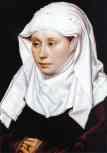 The first master in Flanders who tried to change the established way and
add new imagery to his paintings was Robert
Campin (c. 1375-1444), also known as the Master of Flémalle,
though not all art historians agree that Campin and the Master of Flémalle
were the same person. The realism of the details, attention to faces, and
depth in the compositions are characteristic of Campin.
The first master in Flanders who tried to change the established way and
add new imagery to his paintings was Robert
Campin (c. 1375-1444), also known as the Master of Flémalle,
though not all art historians agree that Campin and the Master of Flémalle
were the same person. The realism of the details, attention to faces, and
depth in the compositions are characteristic of Campin.
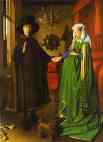 His younger contemporary Jan van Eyck
(c. 1390-1441) was not only one of the first artists who used oils, but
he perfected this new technique so much that for a long time was considered
to be the “father” of oil painting. However, he certainly does not owe
his fame only to this technique. He was faithful to nature, his figures
were true to life, and his representation of space and his portraits made
him one of the greatest painters of his time. His greatest work was the
Ghent
altarpiece, which he painted between 1425 and 1432. His elder brother,
Hubert, started this work, but died in 1426. In 1430, Jan van Eyck settled
in Bruges and opened a studio, which was to become the base for the School
of Bruges. Till the end of the 15th century, artists from Bruges remained
the leading painters of Flanders.
His younger contemporary Jan van Eyck
(c. 1390-1441) was not only one of the first artists who used oils, but
he perfected this new technique so much that for a long time was considered
to be the “father” of oil painting. However, he certainly does not owe
his fame only to this technique. He was faithful to nature, his figures
were true to life, and his representation of space and his portraits made
him one of the greatest painters of his time. His greatest work was the
Ghent
altarpiece, which he painted between 1425 and 1432. His elder brother,
Hubert, started this work, but died in 1426. In 1430, Jan van Eyck settled
in Bruges and opened a studio, which was to become the base for the School
of Bruges. Till the end of the 15th century, artists from Bruges remained
the leading painters of Flanders.
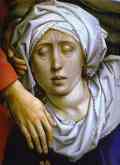 Rogier
van der Weyden (1399-1464) was an apprentice of Campin in 1527; he
experienced the influence of both great masters, Campin and van Eyck, and
combined their discoveries with his own attitude. Unlike van Eyck, he devoted
more attention to the general effect than to detail in his refined portraits.
In his work all the attention is focused on the foreground. He was of the
greatest influence on Northern European art until about the beginning of
the 16th century.
Rogier
van der Weyden (1399-1464) was an apprentice of Campin in 1527; he
experienced the influence of both great masters, Campin and van Eyck, and
combined their discoveries with his own attitude. Unlike van Eyck, he devoted
more attention to the general effect than to detail in his refined portraits.
In his work all the attention is focused on the foreground. He was of the
greatest influence on Northern European art until about the beginning of
the 16th century.
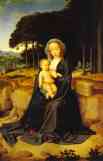 Jan van Eyck and Rogier van der Weyden were never surpassed by their immediate
and by no means unimportant successors. These included Van der Weyden’s
presumed apprentice, the great portraitist from Germany, Hans
Memling (c. 1433-1494); author of interior backgrounds, Petrus
Christus (1415/20-1472); the painter of religious scenes, Dirk
Bouts (c. 1415-1475); and the melancholy and mystical Hugo
van der Goes (1440-1482), who had a great influence on Italian painters.
The last painter of the School of Bruges was Gerard
David (c. 1460-1523), who came from Holland. He was one of Memling’s
apprentices, and produced some strong and austere works.
Jan van Eyck and Rogier van der Weyden were never surpassed by their immediate
and by no means unimportant successors. These included Van der Weyden’s
presumed apprentice, the great portraitist from Germany, Hans
Memling (c. 1433-1494); author of interior backgrounds, Petrus
Christus (1415/20-1472); the painter of religious scenes, Dirk
Bouts (c. 1415-1475); and the melancholy and mystical Hugo
van der Goes (1440-1482), who had a great influence on Italian painters.
The last painter of the School of Bruges was Gerard
David (c. 1460-1523), who came from Holland. He was one of Memling’s
apprentices, and produced some strong and austere works.
 At the beginning of the 16th century, Antwerp became the most important
city in Flanders, its economical and cultural center. The most important
Antwerp master of the first half of the sixteenth century was Quentin
Massys (c. 1464/65-1530). Being influenced by the humanist ideas of
Erasmus, Massys made man the central component of his works.
At the beginning of the 16th century, Antwerp became the most important
city in Flanders, its economical and cultural center. The most important
Antwerp master of the first half of the sixteenth century was Quentin
Massys (c. 1464/65-1530). Being influenced by the humanist ideas of
Erasmus, Massys made man the central component of his works.
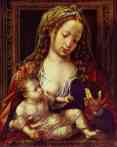 By the 16th century, it became almost compulsory for a young painter to
travel to Italy to study classical and contemporary art. A large group
of leading Flemish artists incorporated the classical imagery so fully
in their work that they were called “Romanists”. One of the first Romanists
was Jan Gossaert, known as Mabuse
(c. 1478-1532). Gossaert was initially a typical representative of the
Flemish style, but after his travels to Italy he was completely enchanted
by classical art, and started to work wholly from its ideas. From this
time, painting mythological scenes and nudes became popular in the Netherlands.
Jan
van Scorel (1495-1562) and Maerten
Jacobsz van Heemskerck (1498-1574) are two other representatives of
Netherlandish Romantism.
By the 16th century, it became almost compulsory for a young painter to
travel to Italy to study classical and contemporary art. A large group
of leading Flemish artists incorporated the classical imagery so fully
in their work that they were called “Romanists”. One of the first Romanists
was Jan Gossaert, known as Mabuse
(c. 1478-1532). Gossaert was initially a typical representative of the
Flemish style, but after his travels to Italy he was completely enchanted
by classical art, and started to work wholly from its ideas. From this
time, painting mythological scenes and nudes became popular in the Netherlands.
Jan
van Scorel (1495-1562) and Maerten
Jacobsz van Heemskerck (1498-1574) are two other representatives of
Netherlandish Romantism.
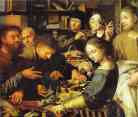 Not all Flemish painters were influenced by Italy, many of them continued
to work in the Flemish tradition. And among them there were painters who
made scenes from daily life their favourite subject. The greatest Flemish
painter of this genre is Pieter Bruegel,
whose name is inseparably associated with scenes of village life. However,
he had a less famous predecessor, Jan
Sanders van Hemessen (c. 1500-after 1575) who painted religious subjects
and scenes from ordinary life in a strongly visual, realistic style, with
a satirical attitude.
Not all Flemish painters were influenced by Italy, many of them continued
to work in the Flemish tradition. And among them there were painters who
made scenes from daily life their favourite subject. The greatest Flemish
painter of this genre is Pieter Bruegel,
whose name is inseparably associated with scenes of village life. However,
he had a less famous predecessor, Jan
Sanders van Hemessen (c. 1500-after 1575) who painted religious subjects
and scenes from ordinary life in a strongly visual, realistic style, with
a satirical attitude.
Bruegel’s work was extremely popular in his own time but he did not
have any followers, because the Italian style had become dominant in the
Southern Netherlands. Only his son, Pieter
Bruegel the Younger, followed his father, simply imitating his work.
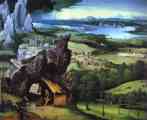 The liberal atmosphere of Antwerp had an inspirational effect, and a new
genre of painting, the landscape, was developed there in the 16th century.
Joachim
Patinir (c.1485-1524) was a central figure in this development. His
paintings still had figures, but they were completely integrated into the
landscape, and that was an entirely different approach. His paintings were
‘world landscapes’; he introduced this fashion, and painting of landscapes
from an ‘elevated point’ was characteristic of the 16th century style in
the Southern Netherlands. Another interesting master, in whose works landscape
was the central element, was Patenier’s relative and apprentice, Herri
met de Bles (c. 1500-1550/60). Bruegel’s youngest son, Jan
Brueghel (1568-1625) also became very famous for his landscapes and
elegant floral arrangements. On the whole the Flemish landscapes of the
16th century were not landscapes painted from nature, but in them, various
elements were combined to produce an ideal.
The liberal atmosphere of Antwerp had an inspirational effect, and a new
genre of painting, the landscape, was developed there in the 16th century.
Joachim
Patinir (c.1485-1524) was a central figure in this development. His
paintings still had figures, but they were completely integrated into the
landscape, and that was an entirely different approach. His paintings were
‘world landscapes’; he introduced this fashion, and painting of landscapes
from an ‘elevated point’ was characteristic of the 16th century style in
the Southern Netherlands. Another interesting master, in whose works landscape
was the central element, was Patenier’s relative and apprentice, Herri
met de Bles (c. 1500-1550/60). Bruegel’s youngest son, Jan
Brueghel (1568-1625) also became very famous for his landscapes and
elegant floral arrangements. On the whole the Flemish landscapes of the
16th century were not landscapes painted from nature, but in them, various
elements were combined to produce an ideal.
To be continued in the next issue...